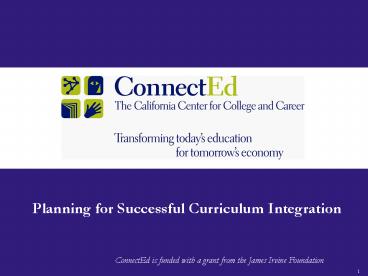Planning for Successful Curriculum Integration - PowerPoint PPT Presentation
1 / 18
Title:
Planning for Successful Curriculum Integration
Description:
ConnectEd's approach to curriculum integration ... Crime Scene Investigation and integrated curriculum unit for health sciences or ... – PowerPoint PPT presentation
Number of Views:231
Avg rating:3.0/5.0
Title: Planning for Successful Curriculum Integration
1
Planning for Successful Curriculum Integration
ConnectEd is funded with a grant from the James
Irvine Foundation
1
2
Paula M. Hudis, Ph.D., Director Program and
Curriculum Development 2150 Shattuck Avenue,
Suite 1200 Berkeley, CA 94704 www.ConnectEdCalifor
nia.org
2
3
Todays Session Agenda
- Welcome!
- ConnectEds approach to curriculum integration
- Examples of multidisciplinary, integrated
curricula - How do the Critical Components connect and
provide a foundation for successful integration? - Planning for multidisciplinary curriculum
integration using a self-assessment rubric
3
4
Our Approach to Curriculum Integration
- Multidisciplinaryrequires teacher collaboration
and student collaboration - Integrates core concepts from several academic
courses and a career-technical course - Addresses both academic and career-technical
standards - Problem or project basedbuilds students
inquiry, teamwork, and communication skills - Combines classroom and work-based learning
4
5
Why Integrate Technical and Academic Material?
- Research on student learning
- Cognitive theory
- Future demands on our students
- Instructional strategy that drives the
curriculum
5
6
Why Integrate Technical and Academic Material?
Research Curriculum integration has positive
effects on student learning
- Helps students apply skills
- Leads to an integrated knowledge base and faster
retrieval of information - Promotes positive student attitudes.
M. Lipson et.al. Integration and Thematic
Teaching Integration to Improve Teaching and
Learning. Language Arts 70/4 (1993) 252-264.
Cited in Kathy Lake, Integrated Curriculum,
www.nwrel.org/scpd/sirs/8/c016.html. Retrieved
6/23/07
6
7
Why Integrate Technical and Academic Material
Across Several Disciplines?
- Cognitive theoryLearning occurs faster and more
deeply when information is presented in
meaningful contexts. - Learning with understanding requires students to
place concepts into a structure - Multiple contextual applicationsespecially
across disciplinesfacilitates organizing
information into a structure or conceptual
framework
7
8
Why Integrate Technical and Academic Material
Across Several Disciplines?
- Future demands our students will face
The complexities of 21st century living, demands
of 21st century careers, and success in
postsecondary education require students to
integrate and apply information from many fields.
8
9
Key Components of the Multiple Pathways Approach
- Challenging, college-preparatory academic
curriculum - Challenging technical curriculum
- Work-based learning connected to academic and
technical learning goals - Support systems and services to ensure student
success
9
10
Where Do the Critical Components Fit Into this
Approach?
- They share 3 overarching goals
- 1. All students can succeed in a challenging,
standards-based academic and technical curriculum
that leads to further postsecondary learning and
career success.
10
11
Where Do the Critical Components Fit Into this
Approach?
- 2. All teachers can succeed in creating an
engaging, challenging, standards-based academic
and technical curriculum within a personalized,
student-centered learning environment.
11
12
Where Do the Critical Components Fit Into this
Approach?
- 3. Any school or school district can build,
deliver, and sustain career-themed clusters
(Multiple Pathways or a system of Multiple
Pathways) that are accessible to any interested
student.
12
13
The Critical Components andStudent Success
- Challenging, standards-based curriculum
- CTE Course sequence
- Articulation with postsecondary education
partners - Academic supports for students
- Career development focus
13
14
The Critical Components andTeacher Success
- Flexible bell schedules
- Professional development
- Shared planning time to facilitate collaboration
- Sustained, engaged partnerships with business,
industry, and higher education
14
15
Building Sustainability Through the Critical
Components
- Administrative support
- Systematic evaluation
- Strong education partnerships
- Strong business and industry partnerships
- Support from parents and community
15
16
Are You are Ready for Effective, Sustainable
Curriculum Integration?
- Examples of multi-disciplinary academic and
technical curriculum integration - Ship Shapean integrated engineering curriculum
unit - Crime Scene Investigationand integrated
curriculum unit for health sciences or law and
law enforcement
16
17
Building a Foundation for Curriculum Integration
and Career Cluster Success
- Conduct self-assessment
- Identify strong and weak areas
- Create a strategic improvement plan
- Build/strengthen key partnerships
17
18
Planning for Successful Curriculum Integration
- Thank you for being here today!
- Penni HudisConnectEd The California Center for
College and Careerwww.ConnectEdCalifornia.org
18































